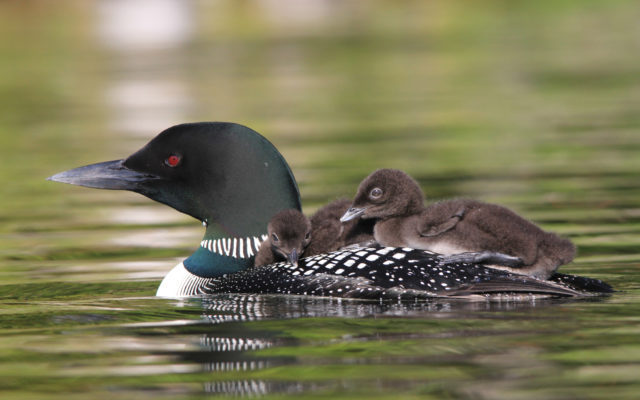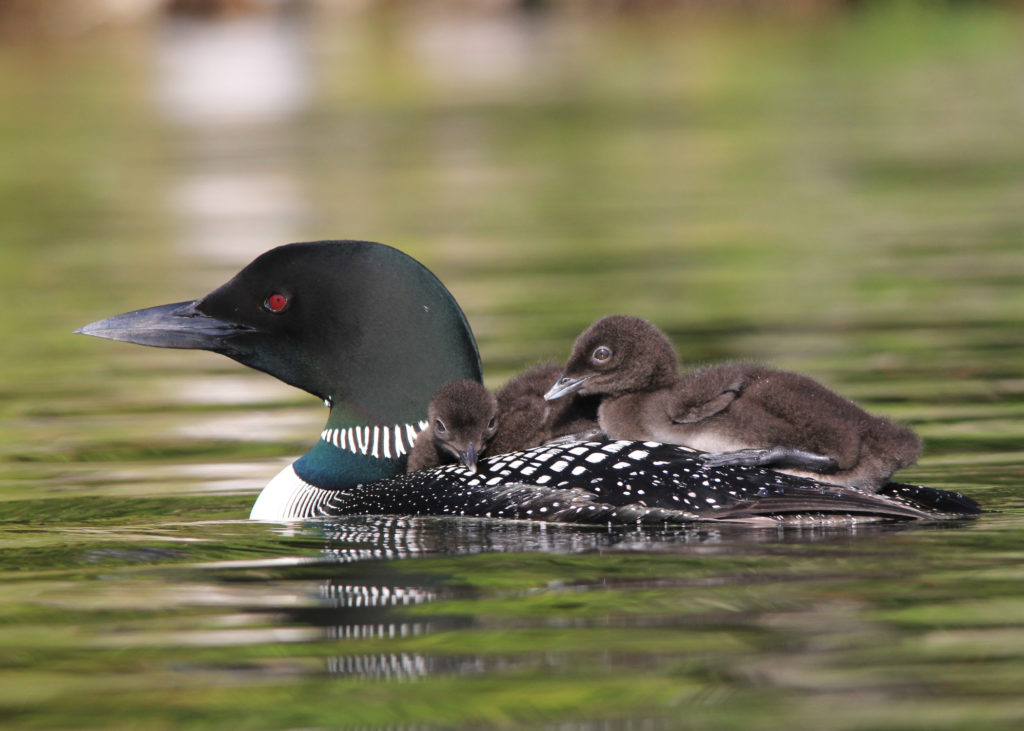
How a loon family warmed the heart of a kayaking photographer
By Sandy Holt Heal
Loons are my absolute favorite aquatic birds and I love photographing them. This summer I was fortunate to be able to spend most of the summer (from July through September) with a mated pair and their two chicks on a local pond. Not only are they beautiful birds, they are fun and interesting to watch and photograph.
Each spring, the first thing I do is load my kayak and head for the water in search of a loon sitting on its nest. Always careful not to get too close so I don’t scare the loon off the nest, I take my 150-500mm telephoto camera lens. I paddle slowly along the shoreline looking for the nest. Loons cannot walk on land like other aquatic birds as their legs are too far back on their body. Therefore, they make their nests at the water’s edge so that they can just slide off the nest into the water when leaving the nest.
Loon chicks hatch out around the first week in July. That’s when I really get excited! These little chicks are so amazing. Once they leave the nest, they never return to it. They start swimming immediately, and when they get tired of swimming, they climb onto the back of one of their parents to rest. That’s when I go crazy with my camera!

ONE WAY TO GET AROUND — Two baby loons ride on their parent’s back in the summer of 2020 while swimming in a pond in Piscataquis County. Baby loons do this when they become tired.
The chicks are small enough for a few days that they can pretty much hide under the wings of their parents. They look so cute when they peek out from under the wings! After they get a bit bigger, they simply ride on the parents’ backs. Now it isn’t all that easy to get up onto Mom or Dad’s back. They kick their little feet like crazy to get enough momentum to get up there. Water splashes everywhere! Many times as I watched the little ones struggle to climb aboard, the adult would rear up and dump the chicks off, back into the water. All that work for nothing!
Loons feed on fish and crawdads (also known as catfish). At first the parents just bring tiny fish for the youngsters. Even then I am amazed at the size the little ones can swallow. After a week or so, crawdads are added to the menu. The parents are busy all day long catching food for the chicks – up to 73 times a day! A hungry loon family can put away a lot of fish. Biologists estimate that loon parents and their two chicks can eat about a half-ton of fish over a 15-week period (shhhh…don’t tell the fishermen that!). I’ve seen them bring up crawdads, minnows, horned pout (catfish) and sometimes things I’ve never seen and have no idea what they are. They also feed on frogs, perch, leeches, minnows, salamanders and algae.
One thing I learned this summer is that when an adult has food for the chicks, they coo to let them know that food is coming. It melts my heart when I hear them do that. Also, if the youngsters get too far away as they get a bit older, the parents will call out a hoot, letting the little ones know they want them closer.
I got such a big kick out of hearing the chicks learning to talk. The first time I actually heard them I couldn’t figure out what I was hearing – I thought at first that I was wheezing! Once I determined that it wasn’t me, I realized that it was the chicks! As the days went by, the “wheezing” got louder so I didn’t have to strain my ears to hear them. Then, when they started practicing their yodel, I had to laugh out loud. I can’t even describe the sound other than that it was comical. Toward the end of my time with them, they were sounding more like adults.

PRACTICE MAKES PERFECT — A young loon known as “Junior” practices running on the surface of the water for takeoff in fall of 2020 in Piscataquis County.
Once the loons got used to having me around, they would swim very close by my kayak. (At this point I was able to switch over to my 55-250mm lens or even my 18-55mm lens.) There were times when I thought one would bump into me! Yes, my heart pounds when they come so close.
Loons grow quickly (from all the meals they get) and soon begin to catch fish and crawdads on their own. Even though I have nothing to do with teaching them how to fish — that’s their parents’ job — I feel so very proud of them. I laugh, cry and cheer them on!
Dad loon (of the loon family I watched this year) left the pond in September for a couple of weeks. He did come back briefly, then left again for good. I felt sad for the chick that I felt was a male (I named him Junior). You see, he had been hanging out with Dad for the last few weeks while Dad was teaching him how to catch his own meals and such. After Dad left, the chick was off all by himself most of the time, coming to join Mom and Sis only occasionally.
Mom loon left later for a while. Then I felt bad for the smaller chick, whom I named Missy. She swam around all day crying for her mom. She was fine though and catching plenty to eat. When Mom came back after a week or so, Missy went crazy! She was all over her mom and was so happy. It sure warmed my heart.
Sept. 25 was my last day on the pond with the loons. I injured my shoulder and could no longer paddle my kayak. On that last day, though, I spent five hours with what I had come to call my babies. On that day, though I never got to see either of the youngsters in flight, I did get to see them practice running on the water in preparation for flight. Wow. Talk about one proud Momma! Yes, I’m talking about me! I knew my babies were going to be okay. After two years on the coast, they will return inland to begin their adult life.
As an amateur wildlife-nature photographer, my summer on the pond was a wonderful, educational, fun, productive, emotional and fulfilling time. I can’t wait to do it all over again next year!
Sandy Holt Heal is from Sebec.
This story is a part of an ongoing series in which photographers share their favorite stories about photographing Maine wildlife. Stories and photos can be submitted to Act Out editor Aislinn Sarnacki at asarnacki@bangordailynews.com. In the email, include your full name and town of residence, as well as the written story and photos you wish to be considered for publication.